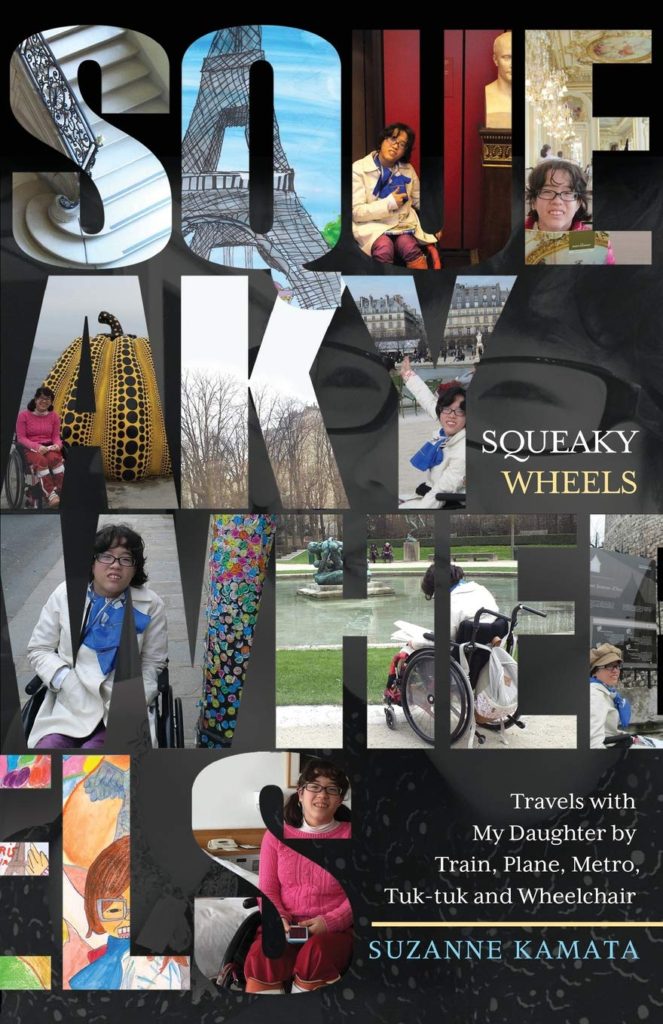Reviewed by Heather Harlen
 The mundane becomes a miracle when I look at the world through travelers’ eyes. A historical marker on a building can be a photo opp, and a pastry at a local bakery can become a revelation. Unfortunately, daily life turns the old Lenni Lenape jasper mines in my town into just an interesting footnote, or the church where the Liberty Bell was hidden becomes less interesting than the bourbon cocktail I’m looking forward to at the bar next door. This is why I need books like Squeaky Wheels: Travels with My Daughter by Train, Plane, Metro, Tuk-Tuk and Wheelchair by Suzanne Kamata (Wyatt-MacKenzie Publishing, March 2019) to remind me that adventure and wonder are everywhere.
The mundane becomes a miracle when I look at the world through travelers’ eyes. A historical marker on a building can be a photo opp, and a pastry at a local bakery can become a revelation. Unfortunately, daily life turns the old Lenni Lenape jasper mines in my town into just an interesting footnote, or the church where the Liberty Bell was hidden becomes less interesting than the bourbon cocktail I’m looking forward to at the bar next door. This is why I need books like Squeaky Wheels: Travels with My Daughter by Train, Plane, Metro, Tuk-Tuk and Wheelchair by Suzanne Kamata (Wyatt-MacKenzie Publishing, March 2019) to remind me that adventure and wonder are everywhere.
Squeaky Wheels is about a mother who wants to show her daughter the world, even though the world might not be ready for her daughter. Lilia, twelve years old, is deaf, uses a wheelchair, and has cerebral palsy. The reader finds out in the prologue that Kamata and Lilia are on their dream trip to Paris but are stuck on an empty subway platform because there is no elevator nor ramp, just a set of stairs that are insurmountable. Then the narrative flashes back to their life in Japan, where Kamata and her Japanese husband are making arrangements for Lilia for school. This sets the reader up nicely to understand the context of the Kamatas’ lives. The third chapter flashes back to when Lilia and her twin brother were born fourteen weeks early. The book then moves in chronological fashion, building up to the point where mother and daughter finally arrive in Paris, their dream destination.
The mother-daughter trip to Paris is magical and complicated. Some of the complications are what I call teenageritis, otherwise known as a young adult being absolutely bored by their parent. Other complications are based on Lilia using a wheelchair, such as having to hunt for elevators or waiting for someone to take them to their seats at a play. But then there are heartwarming events, such as when Kamatata and Lilia take a tuk-tuk, a Thai-style golf cart to the subway, and the driver refuses their fare with a simple “Free!”, or when the staff at the restaurant at the Eiffel Tower pre-cuts Lilia’s food for her so she can enjoy it more easily.
On a metaphorical level, Kamata is the squeaky wheel, always advocating for Lilia to have access to everything she should have access to, from her education in Japan to museums in France. For example, Kamata’s husband makes reservations at a hotel near Disneyland in Tokyo but neglects to get an accessible room. She chalks it up to Japanese culture valuing endurance when her husband shrugs and says he’ll carry Lilia up the stairs. Kamata is frustrated and writes, “I grew up hearing the squeaky wheel gets the grease. If everyone kept silent, women wouldn’t be able to vote, blacks and whites would still be using separate drinking fountains, and there would be no wheelchair ramps in the United States. I think we need to be way squeakier in Japan.”
One of my favorite parts of this memoir is the constant infusion of art into the narrative. Lilia is never without her sketchbook, a beautiful way of communicating to anyone willing to look. Kamata herself is so well-versed in art it felt she was my tour guide through museums around the world. In fact, visiting the Benesse Art Site on Naoshima Island in Japan is now on my bucket list because of Kamata and Lilia’s visit. I am so in love with the idea of going there that I have even researched how much rooms cost so I can start planning my visit. You know you’ve read a wonderful book when you start making vacation plans because of it.


